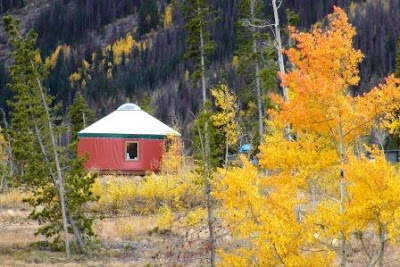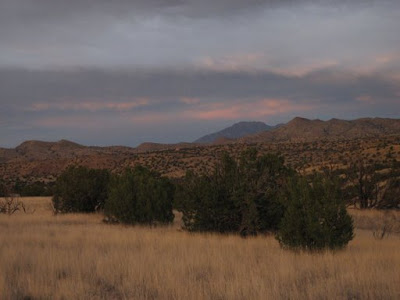By Melissa Fletcher, owner of Yurts of Hawaiiand distributor for the Colorado Yurt Company

Ah, France in the springtime... The wildflowers, the vineyards, the old stone buildings, the YURTS!
I recently had the great pleasure of representing my business, Yurts of Hawaii, and our top notch manufacturers, The Colorado Yurt Company, at the first World Yurt Maker's Conference, held near Pont d'Arc and Gorges de l'Ardeche, France. The event was held at Canvas Chic's beautiful campground that is filled with rustic style yurts and canvas tents. The orchestrator's, Lucy and Nitsan of Spirit's Intent, helped build a beautiful, two-story yurt palace to be the central gathering place for the event. Several attendees brought their own, hand crafted yurts, that they set up and stayed in, the rest of us rented accommodations in the yurts and tents present.

A portion of the invitation explains a bit of the inspiration behind the gathering:
As yurt makers, we have all been captivated by something, an essence of the
structure itself, and beyond it to a living craft and a way of life. It has become an increasingly competitive market, especially in the UK and the USA, and in guarding one's part of that, one can separate oneself from a collective possibility (that) we can all share... we are calling everyone to discover what there is in the collective and to tell their story. (We will begin with) nomadic tents... introduce the origins and traditions of the structure. We will follow (with) the story of the yurt from its nomadic origins and how it came to the West, to developments of the structure, possibilities, uses, innovations and where it is going. There is a magical possibility of the yurt being the structure in the next stage of eco-evolution".
It was a small, yet rich gathering of yurt people from all over the world, each of us bringing our different experiences to share and learn from. We discussed different aspects of the trade and shared challenges, wisdom, various philosophies and our common stories of working with yurts. It was an affirmation and pleasure to meet so many others who are using yurts to bring about positive changes in our world. The event was held during the full moon weekend of May 8 - 10th, 2009 and attendees are hoping to make this an annual or biennial event.

Lucy and Nitsan and Lodewijk van den Belt, owner of the Canvas Chic campground, were responsible for making this vision a reality. They provided a wonderful menu for the duration of the event; think hand made breads, fresh fruit over porridge, roasted wild pig with potatoes, delicious salads... They gathered scholars, pioneers and craftspeople, several of whom were invited to speak and share their knowledge, ideas, and love for these structures. Among the speakers were (Alphabetically):
Bill Coperthwaite Founder of 'The Yurt Foundation', author of "A Handmade Life: In Search of Simplicity"Bill's reputation has preceded him with many in the yurt world. Credited with making the first yurt in the USA in 1962, he has incorporated this passion in his life along with other inspiring philosophies regarding community, education and encouragement for our fellow human beings. His joyful passion to create sensibly as well as artistically is downright contagious. Bill shared a bit of his personal journey, highlighting important lessons he's learned along the way, as well as design changes that he has made to the original yurt structure throughout the years. It was readily apparent that, much as his yurts are designed, he considers his life a constant and joyful work in progress.

"The main thrust of my work is not simple living - not yurt design, not social change, although each of these is important and receives large blocks of my time. But they are not central. My central concern is encouragement - encouraging people to seek, to experiment, to plan, to create, and to dream. If enough people do this we will find a better way".
Froit Bolara, a traditional Mongolian yurt builder, a person learns quickly that you can trust Froit to be straightforward in saying what he thinks. He is what I would consider to be a purist, holding fast to the opinion that anything other than a traditional Mongolian yurt that uses felt and traditional materials, is not a yurt. Many yurt lovers disagree with that statement, but I do believe that this attitude has its benefits; by keeping as close as possible to traditional yurt construction techniques, designs and materials, the original structure is kept pure and rooted in its native environment. I believe his is a critical role, as many others work to modify the yurt for different environments and standards. Rene Mueller reflected these thoughts quite articulately, "I think it requires someone like him to stick with the classics and he might even serve a greater purpose than he realizes, to maintain part of the Mongolian yurt culture, which is about to decline and vanish. As absurd as it often is, outsiders recognize the value of a culture whereas the natives already lost some of the trust in their values. At the same time, the value system of the entire world is in motion, and very few things seem to remain untouched from the changes".
 Dr. Peter Andrews and Mugul Andrews
Dr. Peter Andrews and Mugul Andrews, Anthropologists, Author/Illustrator of "Nomad Tent Types in the Middle East". Peter and Mugul were a delight to meet. They shared many tales of their travels and discoveries all over the Middle East. They discussed the social relevance intertwined in the many traditions of the region and showed us countless examples of how these traditions were interwoven in the culture's nomadic homes. Peter and Mugul started in their 20's to search for and preserve information regarding the cultural significance, actual technique and materials used in various tent-like shelters used throughout the region. Dr. Andrews states on his very informative site,
http://www.andrewspeter.info/ .
"I started, as an architect, with the simple but ambitions aim of making a survey of nomad tents throughout the Muslim world. It rapidly became obvious that if I were to understand the ethnological context, tribal history, technology and terminology in comparison, an architect's training was insufficient. I had to set about acquiring an orientalist's training, and an ethnographer's, if not an ethnologist's, skills".
The subject has been a shared, lifelong passion between them and the depth of their findings is staggering. Peter and Mugul have given a priceless gift to the world through their tireless preservation of this quickly disappearing knowledge.
 Day 1 Events:
Day 1 Events: Presentations by Peter and MugulGetting to know each other. Showing of the Mongolian movie, "Tegris".
Day 2 Events: Spirit's Intent gathering in second story of the central yurt. Slide show and discussions with Bill Coperthwaite. Circle meeting, dancing, dining and music.
Day 3 Events: Presentation and discussion with Froit BolaraPresentation and slide show with Peter and Mugul. Construction of 'Playhouse Yurt' with Bill Coperthwaite and all attendees.
Throughout the gathering, Gabrielle Willand, a film director and her film crew were present, documenting our discussions, thoughts and perspectives. This was an added windfall that Lucy and Nitsan were presented with at the last minute. Perhaps the film crew's presence caused some people to be a bit reserved at first, but soon it became second nature and I believe we all look forward to seeing what was captured by the willing documentation.
- A wide variety of topics were discussed throughout the conference, including:
- The search for durable, affordable and eco-friendly materials
- Meeting various building codes
- Keeping to the nature of yurts/keeping things simple-Incorporating sustainable/Local materials
- The benefits of predictability and permit-ability associated with the more 'engineered' yurts found in the States.-Defining the term 'Yurt'-Keeping yurts accessible to everyone
- Redefining mounting misconceptions surrounding the idea of "home", "shelter", "castle"
In conclusion, I left this conference with shifted paradigms, all kinds of them, all over the place. I came away with an understanding that all of us working with yurts are working on various aspects of the same puzzle. I left secure in the knowledge that we are a community, within this world community, that is waiting to be developed. Many times in this community there is competition, it is inherent in any common industry, but the underlying beauty in this particular industry, is that we are all using yurts to help facilitate positive changes in this world, a world that is primed and ready for some serious, positive change. If we can agree that this is a common goal, then there are countless ways to collaborate and work together for the benefit of all.

I invite further discussion and also want to invite all yurt makers to check out Becky Kemery's website, http://www.yurtinfo.org/. She has shared news of a 'Yurt Guild' for all North American yurt companies and has included a private, 'Companies Forum' on the site as well, an ideal place for yurt companies to begin dialog and discuss industry issues. To join the forum you can register by sending your info to: webmaster@yurtinfo.org .
There were many people that I met that deserve special mention, but really, everyone present deserves a bit more than I'm equipped to provide here. I look forward to learning more about what each person brings to the field in the coming years.
And some surprising news! We are looking forward to hosting a future World Yurt Maker's Conference here in Hawaii. So far we are preparing for speakers, lodging and a yurt building workshop with Bill Coperthwaite. We are hopefully aiming for this time next year, but, having never pulled one of these together before, it might take an extra year to pull it together. Anyone who is interested, please get on the mailing list by emailing me at http://www.yurtsofhawaii.com/contact.html .
Aloha Nui Loa to you all
~Melissa Fletcher











































